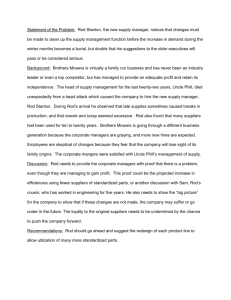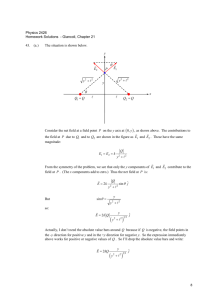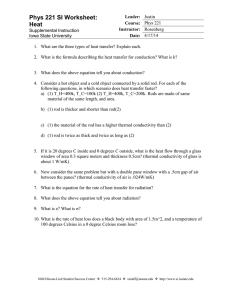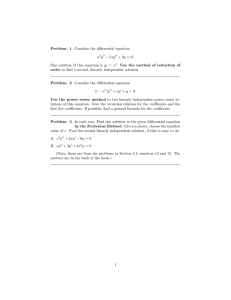1. The Rectangular Waveguide Resonator
advertisement
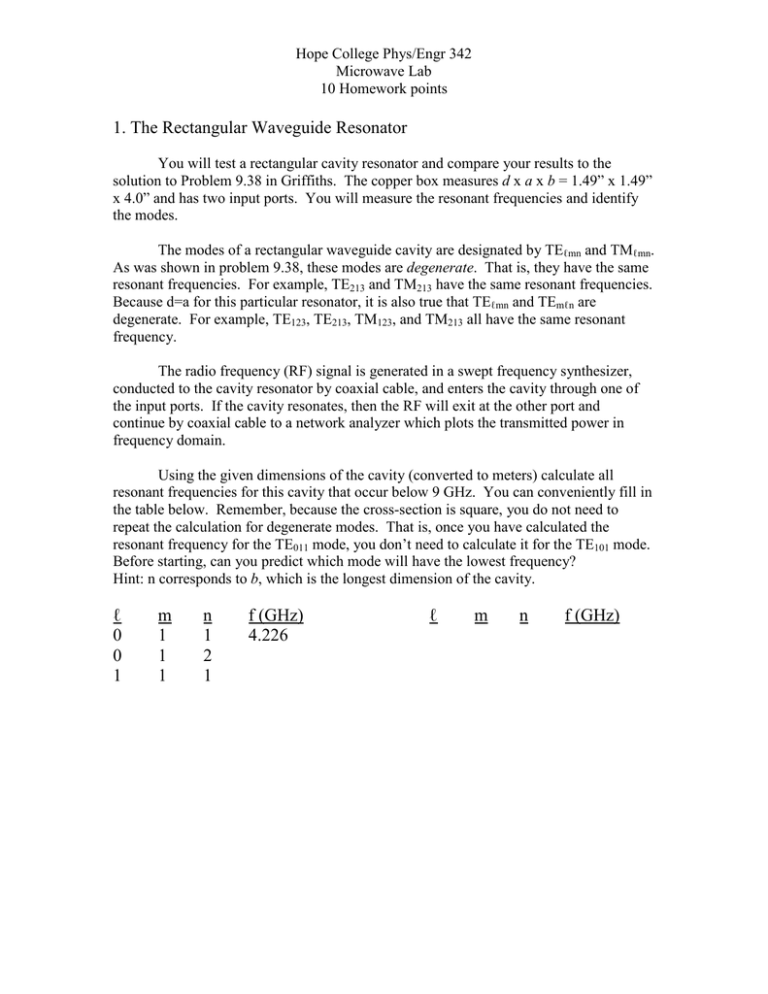
Hope College Phys/Engr 342 Microwave Lab 10 Homework points 1. The Rectangular Waveguide Resonator You will test a rectangular cavity resonator and compare your results to the solution to Problem 9.38 in Griffiths. The copper box measures d x a x b = 1.49” x 1.49” x 4.0” and has two input ports. You will measure the resonant frequencies and identify the modes. The modes of a rectangular waveguide cavity are designated by TEℓmn and TMℓmn. As was shown in problem 9.38, these modes are degenerate. That is, they have the same resonant frequencies. For example, TE213 and TM213 have the same resonant frequencies. Because d=a for this particular resonator, it is also true that TEℓmn and TEmℓn are degenerate. For example, TE123, TE213, TM123, and TM213 all have the same resonant frequency. The radio frequency (RF) signal is generated in a swept frequency synthesizer, conducted to the cavity resonator by coaxial cable, and enters the cavity through one of the input ports. If the cavity resonates, then the RF will exit at the other port and continue by coaxial cable to a network analyzer which plots the transmitted power in frequency domain. Using the given dimensions of the cavity (converted to meters) calculate all resonant frequencies for this cavity that occur below 9 GHz. You can conveniently fill in the table below. Remember, because the cross-section is square, you do not need to repeat the calculation for degenerate modes. That is, once you have calculated the resonant frequency for the TE011 mode, you don’t need to calculate it for the TE101 mode. Before starting, can you predict which mode will have the lowest frequency? Hint: n corresponds to b, which is the longest dimension of the cavity. ℓ 0 0 1 m 1 1 1 n 1 2 1 f (GHz) 4.226 ℓ m n f (GHz) Hope College Phys/Engr 342 Microwave Lab 10 Homework points Now, measure the resonant frequencies using the swept signal synthesizer and the network analyzer. Identify the mode using the TEℓmn designation. f (GHz) Mode f (GHz) Mode 2. The Half-Wave Coaxial Resonator Just like a vibrating string or an organ pipe, a metal rod suspended in air will resonate when exposed to an electromagnetic wave whose wavelength is commensurate with the rod length. When the rod sees a wave, currents will be induced in the rod. Of course, there can be no current at the ends of the rod, since it would have nowhere to go. So, oscillating current does not easily exist in the rod unless the current has nulls at the ends of the rod. If the current has nulls at each end, then there is a current maximum in the center. A graph of current along the length of the rod will resemble half a sine wave, and the length of the rod is half the wavelength of the exciting electromagnetic wave. If a metal rod is suspended in thin air and I want to know the resonant frequency, I would measure the length of the rod, L, and calculate the frequency, fo, that has wavelength, 2L. The rod will also resonant at 2fo, 3fo and so on. If the rod were hanging around by itself in free space, a cross section of its E and B fields, with the rod coming out of the page, is straight forward to sketch: The problem with attempting to realize this is that the system is perfectly leaky. That is, fields fill all of space, and I don’t have a way to get energy into it. Because the electric fields terminate at infinity, and the magnetic fields decay as 1/r out to infinity, it would take an infinite amount of input energy to excite this resonance. (The magnetic field energy of a wire is ∞. Try it using Equation 7.34.) So, a more practical half wave resonator is realized in the coaxial configuration: v E v B Hope College Phys/Engr 342 Microwave Lab 10 Homework points v E outer cavity v B Now, the electric fields terminate on the outer cavity wall, and the magnetic fields don’t go to infinity. The electric field is maximum at the two ends of the rod, and the magnetic field is maximum right in the center, where the current is also a maximum. A mode that has this field pattern is called transverse electromagnetic, or TEM. Here is an exercise. 1. Measure the length of the rod and calculate its lowest resonant frequency. 2. Inspect the coupling antennas. Will they more efficiently couple to the electric or to the magnetic fields? Position the rod inside the cavity to get efficient coupling. 3. Measure the first two resonant frequencies on the network analyzer. Brainstorm the reasons why there is a discrepancy between calculation and measurement. 4. Are the resonance peak widths infinitesimal? Measure the Q (=f/∆f) of the first resonance. The Q of the half-wave coaxial resonator is related to the surface resistance, Rs, (or rather, the real part of the surface impedance) of the copper by 1 = Q 1 1 + ba b 2πfµ o ⋅ ln a Rs where a=inner radius, b=outer radius and R s = πfµ o ρ . Using the measured Q, calculate the resistivity, ρ, of copper and compare to its book value of 1.68x10-8 Ω⋅m.



